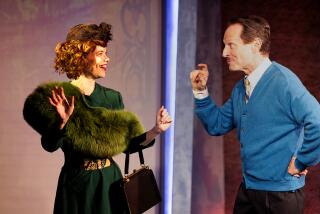Does Riefenstahl Make a Fascist Statement?
Flicking through the Calendar section, I was surprised to see a full-length photograph of a naked woman, her skin slicked down with oil. It wasn’t an ad for the Tropicana’s mud wrestling, nor Playboy’s final acceptance into the mainstream; no, this was a review by David Pagel of Leni Riefenstahl’s latest show at Fahey/Klein Gallery (“Leni Riefenstahl: Grace and Beauty in Africa,” Sept. 20).
It is unusual to see full-frontal nudity in a daily paper (at least in the United States), and I presume its acceptance was due to it being a photograph of a black, “tribal” woman. The reasoning must be that she is in her “natural” state, rather than this being a prurient sexual display, which it would have been had she been a white woman. Don’t misunderstand me: I have nothing against nudity, but I am bothered by this racial double standard.
It’s a fallacy to pretend that “tribal” women are not sexually alluring to white men; National Geographic and its ilk have provided the first masturbatory images for many a young boy. I’m reminded of the massive disavowal by generations of white Southern American boys, say, or white South African boys whose primary caregivers and first objects of affection and sexual interest were black nannies, but who then grew up to perpetuate a slave or apartheid system.
That would make for an illuminating study, but I’d like to concentrate on the photograph’s caption, “Leni Riefenstahl’s photographs celebrate the beauty and sensuality of tribal people in the Sudan,” and on Pagel’s concluding sentence, that “it’s important to remember that Riefenstahl is neither an anthropologist nor a tourist, but an artist--an old-fashioned Romantic, whose quest for beauty has taken her to the far ends of the Earth.”
Beauty uber ales may well be Pagel’s usual shtick, but the questions that he raises here but leaves unanswered (and unconsidered when it matters most) are whether the pursuit of beauty is neutral and whether it transcends other concerns such as--in this case--a melding with fascism.
There’s a spectrum of debate and opinion whether art and artists should bear social responsibility or whether it is all a matter of individual freedoms, but to suggest that the pursuit of beauty overrides all other concerns smacks a little too much of the particular past that Riefenstahl’s apologists would have us conveniently forget.
Certainly, there is often a nostalgia and sense of loss that motivates the pursuit of beauty--a nostalgia that also seeps into acts of rebelliousness and personal liberation, whether from henna parties or tattooing and piercings of “urban primitives” or goddess-worship or drumming circles or suburban rap or militant environmental groups. It’s unsurprising that such examples fall on the left of the political compass, but prevailing models for Euro-American rebellion have always tended to be drawn from philosophies and physical markings of “the primitive” and the “oriental.”
What is more problematic is that such nostalgia fits seamlessly into the right in general--most notably its various fundamentalist strains--and into a fascist aesthetic in particular. It’s not necessary to know about Riefenstahl’s Nazi ties; her ongoing obsessions with the noble savage as an untainted specimen fixed in time, as well as her focus on blood and physical prowess, are sufficient cause for question.
The Nazis didn’t invent the cult of the body, but, syncretic breed that they were in spite of their protestations at purity, they were adept at tapping into an existing body culture, especially of masculinity, and overlaying it with regurgitations from every past imperial or martial society.
They were also complex if not contradictory racists; they could feel personal injury at the success of Jesse Owens at the same time as admiring the physicality of tribal people. Riefenstahl’s current images, particularly because of their “beauty and sensuality,” fit snugly into National Socialist ideologies of racial purity. The Jews were targeted as much because they were Jewish and European, and because they were integrated into European society and not safely at a distance as are the Nuba of Sudan.
Despite Riefenstahl’s skills and previous cinematic innovations, her work remains a celebration of the mythically classical and, in that sense, is profoundly anti-modernist. To the Nazis, modernism was degenerate precisely because it was a process of mongrelization. Riefenstahl travels widely, even “to the far ends of the Earth,” but continues to celebrate untainted spheres of separation. It’s one thing for her to enter the world of the Nuba; it would be another for the Nuba to enter hers.
Pagel has it wrong. If only Riefenstahl were merely a tourist and anthropologist; unfortunately, even though she’s seductive with a camera, her fascist affiliations are still somewhat naked.
Allan deSouza is a visual artist and fiction writer. He lives in Los Angeles.
More to Read
The biggest entertainment stories
Get our big stories about Hollywood, film, television, music, arts, culture and more right in your inbox as soon as they publish.
You may occasionally receive promotional content from the Los Angeles Times.










